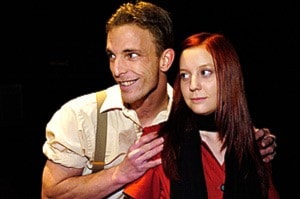The Guild’s production of Dark of the Moon is supposed to be unsettling.
The program even comes with a warning — “Mature content: May be disturbing to some.”
But Vancouver-based director Tanya Marquardt takes it one step further.
Her audience becomes uneasy as soon as the Guild Hall opens its doors.
Lying on her back in the middle of the floor — which is hard-packed dirt — there’s a thin young woman with a red cotton dress spread over her bare legs.
She looks vulnerable.
And it’s uncomfortable.
To make things worse, members of the audience crossing to their seats on the far side of the theatre have to step over the motionless girl.
She’s in the way.
Marquardt is blurring the conventional theatrical boundaries between actor and audience before the play begins.
Staged in the round, seats line three of the theatre’s four walls, which are plastered with scripture.
There’s an Ozark-like atmosphere in the place.
Murmuring and passing flasks in the shadows, the hillbilly cast watches as the audience settles in.
And staring at each other across the dirt stage, the audience ends up studying itself in a disconcerting role-reversal.
Dark of the Moon is billed as an Appalachian Gothic romance that ties the supernatural world of witches to a small, world of rural religious fanaticism.
Written by cousins Howard Richardson and William Berney in 1942, the play was originally created as a satiric response to a bad folk production at the time.
Now, more than 65 years later, the script lacks context and struggles to stand on its own.
A witch boy, Graham Rudge, falls in love with a mortal girl named Barbara Allen, Shelby Holt.
After having his way with her on the mountain, he begs the other witches to help him become human so he can live with his true love.
Conjur Woman, Nancy Smythe, agrees to help him, but only on the condition that Barbara Allen stay faithful for a year.
Young love fights small-town religious fervour in a production that pits the individual against mob psychology.
The production starts off on the dark side, where the witches meet on the mountain.
The play’s real dark side — religious extremism — has yet to rear its ugly head.
Eerie lighting and overly large movements add to the supernatural feel as the Fair Witch, Fiona Solon and the Dark Witch, Susan Ellis, lurch and curl around the stage.
Stilted and somewhat spaced out, Rudge’s witch boy seems otherworldly.
Although effectively creepy, Rudge’s large, spidery movements overshadow his lines, which lack emotional conviction.
Conjur Man, Doug Neil, falls into a similar trap.
Hunched and hobbling, Neil calls out his lines in a rough scratchy voice that takes precedence over what he’s actually saying.
After the dark world of witches, the transition to the revivalist hoedown of the hillbilly human world is a palpable relief.
Dave Haddock and Ben Barrett’s upbeat hymns get feet stamping and the audience clapping.
Dancing and singing, the cast members move from their dark supernatural roles to their hick counterparts with relative ease.
But again, big movements overshadow the credible delivery of lines.
Only muscle-bound Marvin Hudgins, Chris Lomas, pulls it off.
Cartoon-like in his intensity, Lomas uses movement to buffer, rather than detract from his role in the perfect marriage of caricature and authenticity.
Mrs. Allen, Smythe, also hits the mark at times, listening and responding to lines rather than spitting them out by rote.
The weakest link is Holt, who’s Barbara Allen is flat and lifeless.
In a script where characters go by names like Uncle Smelicue, Preacher Haggler, and Conjur Woman, and the most common lines are “Howdy,” and “I reckon’,” it is hard to take anyone too seriously.
But despite it’s far-fetched plot, Dark of the Moon manages to touch on some resonate themes.
During the final revival meeting, the actors circle the audience singing and praising the lord, until the whole theatre is swaying and clapping.
By staging the production in the round, Marquardt was able to draw in and use her audience, sweeping them away in a tide of religious fanaticism.
And actors tucked behind the crowd create a soundscape that almost feels subconscious at times.
But overall, Marquardt’s Dark of the Moon lacks the persuasive conviction that the love story demands.
Dark of the Moon runs Wednesday to Saturday until October 20th at the Guild Hall in Porter Creek.
Tickets are available at Arts Underground, and October 10th is pay-what-you-can.
Performances start at 8 p.m.
